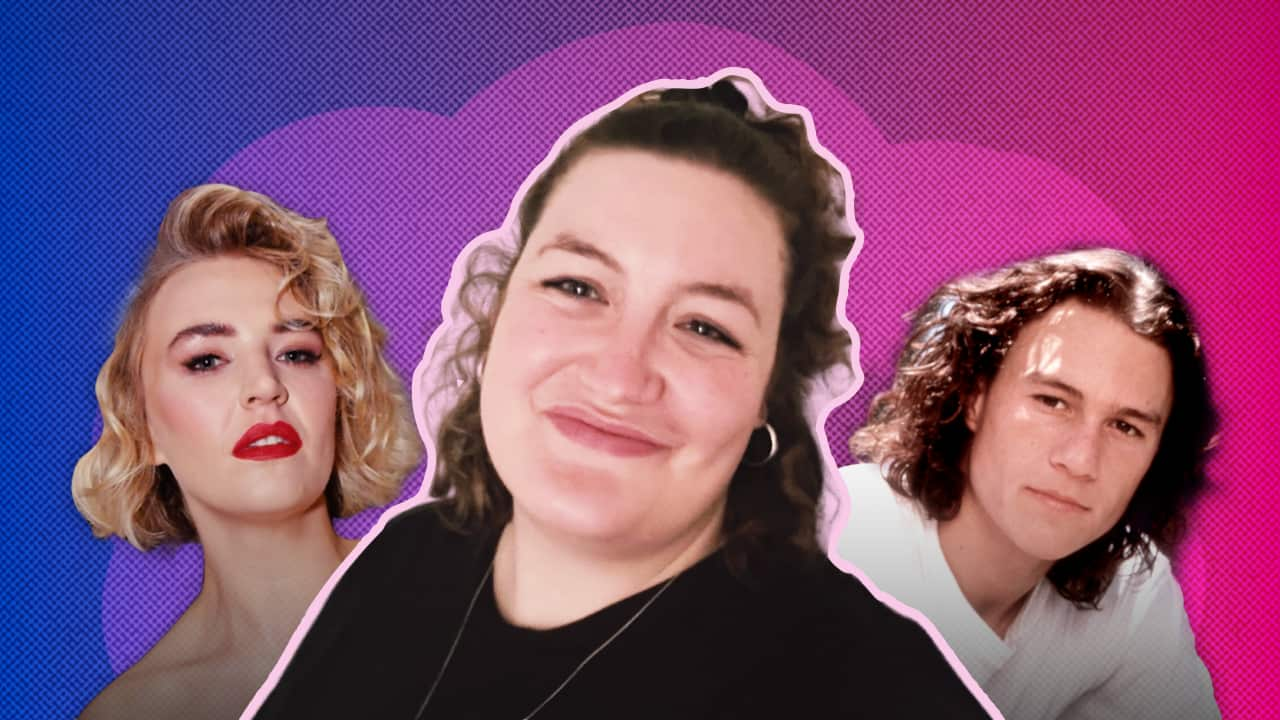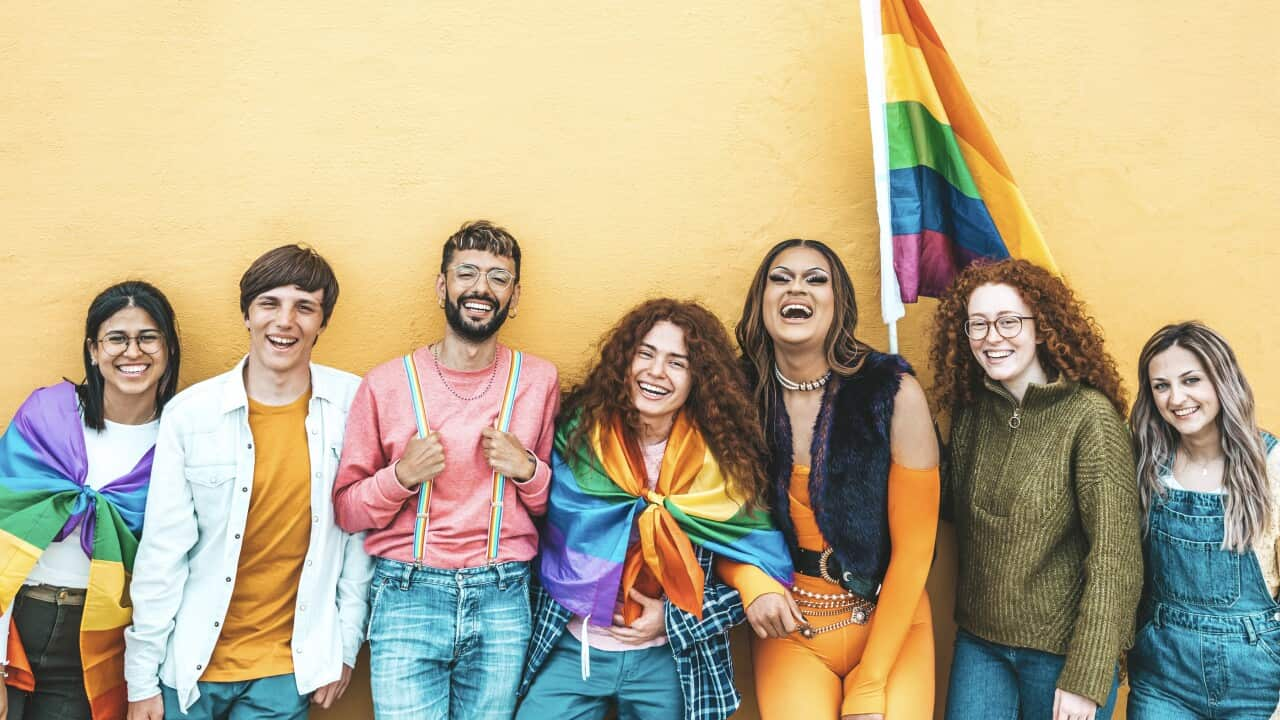If there's one thing I was sure about from a young age, it's that I was straight.
While I wouldn't exactly describe my younger self as "boy crazy", the walls of my childhood bedroom and school book covers were adorned with pictures of my celebrity crushes and all of my romantic attention was directed squarely at men (Heath Ledger as Patrick Verona in 10 Things I Hate About You will forever have my heart).
Even in my teens and 20s, when many of my peers were experimenting with their sexuality, I never had any desire to do the same.
Then a few years ago, seemingly out of the blue, I began to question if this long-held belief I had about myself was in fact true.
If you think stereotypes have some basis in fact, you'd probably say the signs were there all along.

I've been rocking a bob cut on and off since childhood. Source: Supplied / Amy Hall
I also have very few straight friends (you know what they say about birds of a feather), so why did it take me — someone who considers themselves to be pretty open-minded and self-aware — the better part of three decades to realise such a fundamental thing about myself?
A scroll through social media tells me I'm not the only one.
Good luck, babe!
From public figures to people I grew up with, increasing numbers of women appear to be having a queer awakening in their 30s and beyond.
The phenomenon can be partly explained by the impact of compulsory heterosexuality, a term popularised by lesbian feminist Adrienne Rich in her 1980 essay, Compulsory Heterosexuality and Lesbian Existence, in which she describes how being straight is enforced by society and upholds patriarchal systems.
Dr Hannah McCann, a senior lecturer in cultural studies at the University of Melbourne, puts it like this: "Compulsory heterosexuality does what it says on the tin … and is baked into assumptions about what 'successful' adult life looks like, as a kind of married, heterosexual, nuclear family arrangement.
"Ultimately, there's an assumption that men should be the object of women's desire; it's fundamentally built into how we understand gender."
Often shortened to 'comp het', the theory has taken on a new life in the social media age, and is even the subject of Chappell Roan's hit song Good Luck, Babe!
Closely linked to compulsory heterosexuality is heteronormativity, McCann explains.
"Heteronormativity just means that heterosexuality is treated as natural and normal in society and it's unmarked, so it operates in the background, no one questions it," she says.
The fundamental assumption is that you're heterosexual until proven otherwise.
That assumption can lead people to not even consider questioning their sexuality, especially if they experience some level of attraction towards the opposite sex.
Professor Jennifer Power from the Australian Research Centre in Sex, Health and Society says it can inhibit self-reflection. "If you are just following that norm, that is not a decision in some ways, it's just the way you go," she tells me.
McCann agrees and says those norms and expectations filter into every aspect of our lives, particularly narratives about sexuality that dominate popular culture and the media.

For most of my life, I thought I was straight. Source: Supplied / Amy Hall
"There's not a lot of room for being fluid at all," she says.
"There isn't a common narrative, for example, that says: 'I felt completely heterosexual, and then I met this person and I realised I was not'.
"The media, particularly, latches onto easy, very discrete narratives, and those get replicated over and over, and then people feel like if, in their individual circumstances, they don't map onto that narrative that, then mustn't be them."
Being a teenager during the peak "girl crush" era led me to assume that feeling especially drawn to or experiencing nervousness around other women and gender diverse people was due to my admiration of them — rather than any romantic or sexual attraction.
Even if I had been aware at the time that those feelings were anything but platonic, I don't know that I would've felt comfortable being open about it, lest I give my bullies more ammunition.
My lack of desire to get a boyfriend just for the sake of it led to me being labelled a "lesbian", with comments often made that other girls shouldn't get changed for PE in front of me because I'd "enjoy it".
Never mind that none of my classmates were even remotely my type or that some of the girls who bullied me would hook up with each other at sleepovers.

Credit: Yarn
Generational differences in sexual identity
While increasing numbers of people are coming out later in life, younger Australians are still significantly more likely than older generations to identify as non-heterosexual.
, one in 10 people aged 20 to 24 in 2022 was LGB+ — meaning they identified as lesbian, gay, bisexual, or used a different term other than straight or heterosexual to describe their sexual orientation. That number decreases with age, with just 0.6 per cent of Australians 75 and older identifying the same way.
Analysis published in the academic journal Population Studies, suggests Australia's LGBTIQ+ community more than doubled in size between 2012 and 2020, primarily as a result of larger numbers of young women identifying as bisexual.

Younger Australians are much more likely than older Australians to identify as non-heterosexual. Source: SBS News
"The more space that we make for people to be whoever they want to be, whoever they are, then people can not only articulate themselves that way and use the labels that they choose but actually look in the mirror and say, 'Actually, that's who I am' [and] have a realisation."
Moving through different life stages and events can also afford a greater understanding of sexuality, Power says.
I think people's awareness of their sexuality is always in the context of their life.
"If they've been on that heteronormative path and it's relatively comfortable, and maybe they're aware of their sexuality to some extent, but it's not been pressing, then it makes sense that they might not think about it until later, or it might not be something they've needed to pursue in any active way until they're older or their life shifts or something else becomes visible for whatever reason.
"In your 30s, women particularly have to start making decisions — even if that's not something that's really conscious in your head — about what their life's going to look like in terms of relationships and babies and everything else, so it doesn't surprise me that that's a point where it gets more pressing for some women."
Realising I may not be straight came around the same time I discovered two other significant things about myself: having biological children — or any at all — wasn't as important to me as it had once been; and many of the struggles I was experiencing were a result of .
But because it felt like something I should have been aware of from a much younger age — like every other bisexual person I knew — and that my attraction to women and gender-diverse people is a lot narrower than my attraction to men, I didn't feel "queer enough".
The moment I knew
The moment I realised my bisexuality was undeniable came when I was 31 years old.
I was standing under a circus tent on the outskirts of Sheffield, England, surrounded by thousands of strangers, watching one of my favourite artists perform.
I had been travelling solo around the UK and Ireland for a few weeks, which gave me a lot of thinking time, and as the sounds of Self Esteem's Prioritise Pleasure rang out through the crowd, a wave of clarity washed over me.

Self Esteem singing into my soul on a day I'll never forget. Source: Supplied / Amy Hall
Whether that has to do with feeling like an anxious, inexperienced teen all over again, the state of modern dating, my awareness that biphobia is still very much alive and well in parts of the queer community, or a bit of all three, remains to be seen.
But I guess baring my soul on the internet is a step in the right direction.




